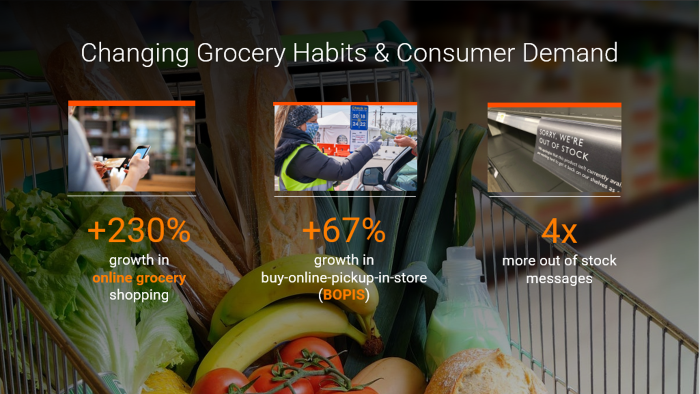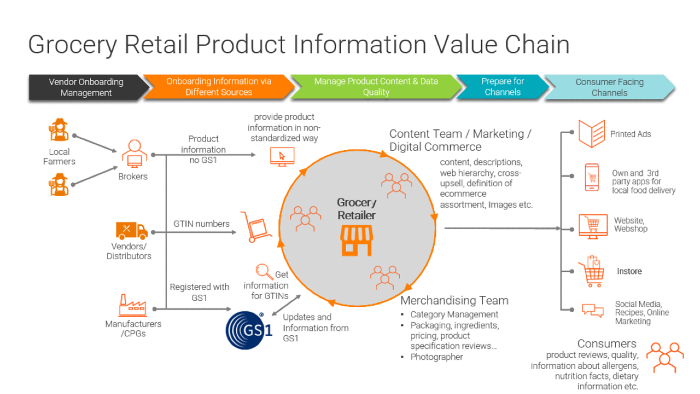How Grocery Retail Delivers An Integrated Product Experience Across Touchpoints
Since the beginning of the global pandemic in 2020, grocery retail has experienced increased demand, especially when it comes to digital sales channels, and uncovered new opportunities. According to an Adobe study of over 1,000 U.S. consumers, online grocery shopping grew by 230% compared to pre-pandemic levels. Also, e-commerce sales at Kroger, the largest U.S. supermarket chain, soared by 116% in the most recent fiscal year during the global health crisis. As consumers looked for more convenient and safe ways to buy food and avoid potential shipping delays, buy-online-pickup-in-store (BOPIS) options also grew 67% year over year (as of February 2021).

However, grocers are also facing multiple challenges, due to changing consumer habits and demand and the accelerated shift towards digital channels. This is especially true when it comes to providing consumers with an integrated omnichannel experience based on trusted product information.
Product content often comes from different sources and is syndicated to several sales and marketing channels. This means grocery retailers need to ensure that they have standardized ways to manage product content efficiently while guaranteeing that information is both consistent and accurate across channels—and relevant, contextualized, or even personalized for each individual channel.
Omnichannel Commerce in Grocery Retail
To be successful, grocery retailers engaged in omnichannel commerce need to provide customers with a seamless and engaging buying experience across all touchpoints, including buy in-store and buy online—whether customers are using the online shop, the grocer’s own mobile shopping app, or a third-party app for local food delivery. For online shoppers, most grocers now offer several delivery options, including BOPIS and home delivery service for a specific date or and timeframe. Grocers also need to be able to reach customers via multiple marketing channels, such as printed ads, social media, and online marketing.
All of these efforts to deliver an integrated omnichannel experience to customers require accurate, complete, and up-to-date product content.
Product Information Management Sources in Food Retail
Typically, grocers receive product content from a variety of sources:
- Brokers are dealing with mainly fresh products from local farmers and typically share product information with grocers in a non-standardized way and without using GS1 standards.
- Vendors / distributors are usually providing Global Trade Item Numbers (GTINs) to their grocer customers, who can then get the relevant product information via the GS1 Global Data Synchronization Network (GDSN).
- Manufacturers, mainly CPG companies, are registered with GS1, so that the retailer can get product information from the GDSN.

At the grocer, different teams take care of next steps in the product information supply chain to prepare data for channels and ensure an informed purchase journey for consumers, which includes product reviews, information about allergens, dietary information, etc.
- The Merchandizing or Category Management Team oversees the retailer’s product inventory to ensure the shelves are well presented. They make decisions related to stocking, pricing, and presenting goods in retail stores. This team also manages information about packaging, ingredients, pricing, and product specification reviews.
- The Marketing team coordinates with the photographer to ensure pictures or merchandise are available in the right quality and format for printed advertisement, social media, in-store ads, or digital commerce, including website, apps, and third-party apps or other local food delivery services.
- The E-commerce and Content Team takes care of creating and reviewing product content, including product descriptions, and preparing this content for different sales channels. They also define the hierarchies of the online shop or website, select products for cross- or upselling (“You may also like,” cooking recipes, etc.), and define the ecommerce assortment, since typically not all products are available for online shopping.
How Grocery Retailers Benefit from Product Information Management
No matter the source, inaccurate, missing, or incomplete product information requires the buyers, trading managers, and/or merchandizers at the retailer to verify, complete, or correct data in systems such as PIM or ERP.
If this data onboarding process is manual and inefficient, it leads to delays in time to shelf. Especially for fresh food with a short shelf-life of only days, it’s important to have agile workflows in place while sourcing products locally to get them quickly to market.
According to Adobe, retailers today are struggling to meet demand more frequently. In January 2021, “out of stock” messages were elevated at four times the pre-pandemic levels. Groceries, medical supplies, and pet products were out of stock online more often than other product categories. These supply chain disruptions are an issue especially if there is no 360-degree view of product information, with a trusted view of all vendors and the products they provide. Without reliable insights into their products and supply chains, grocers cannot quickly identify alternate vendors to fill the gaps.
Overall, without an intelligent product information management solution, grocers need to deal with increasing costs, lower sales volumes, and missed market opportunities.
A product information management (PIM) solution helps retailers streamline the entire product information value chain, from the sources to the consumer-facing channels. It helps not only by automating and making workflows more efficient, but also by ensuring product content is accurate, complete, and up to date. The different teams involved—listed above—can easily collaborate on a single trusted view of data and improve operational efficiencies.
This also includes the collaboration with vendors: using a vendor self-service portal that is part of a PIM, grocers can speed up processes and improve the onboarding or update of product data with suppliers and brokers. To streamline GS1 workflows, retailers can connect their PIM with the GS1 GDSN to receive grocers’ specific product information from manufacturers and vendors.
With faster, more efficient, and more accurate workflows, food retailers can speed their time to market by up to 10 times, which ultimately leads to increased sales across consumer touchpoints. Overall, a PIM helps deliver an integrated product experience across touchpoints and improve customer loyalty.
How an Italian Grocery Retail Chain Speeds Time to Market
Coop Alleanza 3.0, one of Europe’s largest food retail cooperatives with 2,700,000 members and 430 stores across 12 regions of Italy, is using Informatica Product 360 solutions to support digital commerce and enrich and validate product data efficiently. This also helps them increase agility and speed-up time to market. The grocery retailer combines customer, product, and sales data from different internal and external systems to create a single source of the truth and personalize the shopping experience for Coop members and customers.
“In just four months, we created a rich product catalog that [enabled] our ecommerce platform, EasyCoop, [to] meet the shifting digital needs. Informatica provided the confidence and ease to manage our product data. And that made it possible for us to reach our goals.” —Andrea Furegon, Digital Innovation Director, Coop Alleanza 3.0.
Next Steps
To learn more about delivering an integrated product experience, read our eBook, “Five Ways to Enhance Product Experience.”








